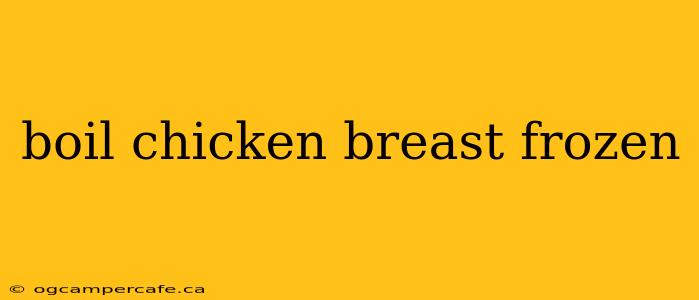Boiling frozen chicken breast might seem daunting, but with the right technique, it's a quick and convenient way to prepare this lean protein. This guide will walk you through the process, ensuring you achieve perfectly cooked chicken every time while prioritizing food safety.
Why Boil Frozen Chicken Breast?
Boiling frozen chicken breast offers several advantages:
- Convenience: Saves time on thawing, ideal for busy weeknights.
- Versatility: The cooked chicken is perfect for salads, soups, casseroles, or shredding for tacos.
- Healthier Option: Boiling is a low-fat cooking method, retaining more nutrients than frying.
- Easy Cleanup: Compared to other cooking methods, boiling requires minimal cleanup.
Safe and Effective Boiling Techniques
Crucial Note: Always ensure your chicken reaches an internal temperature of 165°F (74°C) to eliminate harmful bacteria. Using a meat thermometer is essential for food safety.
Method 1: The "One-Pot Wonder"
This method is perfect for simplicity and minimal cleanup.
- Bring Water to a Boil: Fill a large pot with enough water to fully submerge the frozen chicken breast(s). Bring the water to a rolling boil.
- Add Chicken: Gently add the frozen chicken breasts to the boiling water. Avoid overcrowding the pot; this can lower the water temperature and prolong cooking time.
- Reduce Heat & Simmer: Once the chicken is in, reduce the heat to a simmer. This ensures even cooking and prevents the chicken from becoming tough.
- Cook Until Done: Simmer the chicken for approximately 20-30 minutes, or until the internal temperature reaches 165°F (74°C). Larger breasts will require slightly longer cooking time. Use a meat thermometer to check for doneness.
- Remove & Cool: Carefully remove the chicken from the pot using tongs or a slotted spoon. Allow the chicken to cool slightly before handling.
Method 2: The "Flavor Infusion" Method
This method adds extra flavor to your boiled chicken.
- Prepare Flavorful Broth: Instead of plain water, use chicken broth or a flavorful vegetable broth as your base liquid. Add herbs like thyme, rosemary, or bay leaves for enhanced taste.
- Follow Steps 2-5 from Method 1: Follow the remaining steps from Method 1, ensuring the chicken reaches the safe internal temperature of 165°F (74°C). The flavorful broth will infuse the chicken with delicious aromas and flavors.
Tips for Perfect Boiled Chicken
- Don't overcrowd the pot: Overcrowding lowers the water temperature, resulting in uneven cooking and potentially leaving the chicken undercooked.
- Use a meat thermometer: This is the most accurate way to ensure your chicken is cooked to a safe temperature.
- Adjust cooking time: Thicker breasts will take longer to cook. Always check with a meat thermometer.
- Let the chicken rest: Allowing the chicken to rest for a few minutes after cooking helps it retain moisture and makes it easier to slice or shred.
- Store Properly: Once cooled, store the cooked chicken in an airtight container in the refrigerator for up to 4 days or freeze for longer storage.
Beyond Boiling: Additional Cooking Methods for Frozen Chicken Breast
While boiling is efficient, other methods can yield different textures and flavors:
- Poaching: Similar to boiling, poaching uses gentler heat and often involves flavorful additions like herbs and spices.
- Slow Cooking: Slow cookers are ideal for tenderizing tougher cuts of chicken, although frozen chicken breasts can also be successfully cooked this way. Just add extra cooking time.
- Baking: Baking frozen chicken breast is another convenient option, providing a slightly drier but flavorful result.
By following these guidelines, you can safely and efficiently boil frozen chicken breast, transforming a quick and simple meal prep technique into a delicious and healthy culinary experience. Remember, food safety is paramount; always use a meat thermometer to confirm the chicken has reached the safe internal temperature.
